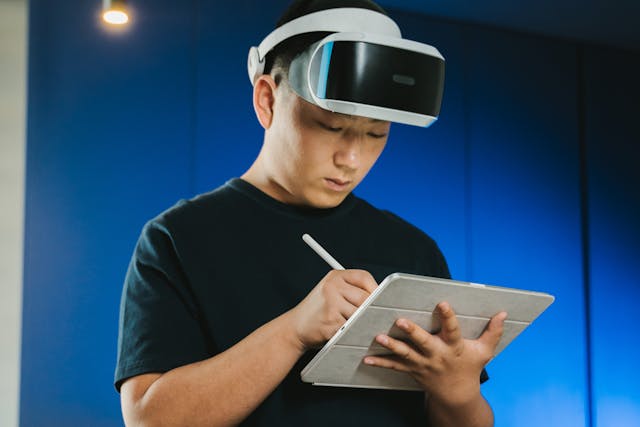

Virtual Reality (VR) and Augmented Reality (AR) are transforming the educational landscape, offering immersive and interactive learning experiences. These technologies bridge the gap between theoretical knowledge and practical application, making learning more engaging and effective.


VR creates fully immersive digital environments, allowing students to explore and interact with content in ways traditional methods cannot. For example, VR can transport students to ancient civilizations, deep ocean explorations, or outer space missions, enhancing their understanding and retention of complex concepts.
One notable application is Google’s Expeditions, which enables students to take virtual field trips to historical sites, museums, and natural wonders. This helps students visualize and comprehend historical events and scientific phenomena in an engaging and memorable manner.
AR overlays digital information onto the real world, providing interactive and meaningful learning experiences. Students can visualize and interact with 3D models, enhancing their understanding of abstract concepts. AR is particularly useful in subjects like science, mathematics, and engineering, where complex ideas can be challenging to grasp through traditional teaching methods.
The Dinosaur 4D+ app allows students to view and interact with 3D models of dinosaurs using flashcards. This interactive approach makes learning about prehistoric creatures engaging and fun, helping students retain information more effectively.
Both VR and AR have unique strengths that, when combined, can create hybrid learning environments. For example, Microsoft’s HoloLens merges AR and VR to enable students to explore the human anatomy in 3D, interactive format. Students can dissect virtual cadavers and perform surgical procedures, gaining hands-on experience without the risks associated with real-life practice.
At Case Western Reserve University, medical students use the HoloAnatomy app to visualize and interact with 3D models of human organs, enhancing their understanding and skills. This immersive approach to learning ensures that students are better prepared for real-world medical scenarios.
VR and AR have been shown to significantly increase student engagement and motivation. Students are more involved in lessons that use these technologies, as they make learning interactive and enjoyable6. For instance, a study by PwC found that learners using VR and AR are 275% more confident in applying their skills and learn four times faster than traditional methods.
These technologies also enable personalized learning experiences, catering to different learning styles and paces. For example, VR and AR can provide interactive simulations for visual learners, gamified lessons for kinesthetic learners, and narrated experiences for auditory learners. This customization ensures that every student can benefit from a tailored educational experience.
VR and AR are revolutionizing education by providing immersive, interactive, and personalized learning experiences. These technologies bridge the gap between theoretical knowledge and practical application, making learning more engaging and effective. As VR and AR continue to evolve, their impact on education will only grow, offering new opportunities for students to explore and understand the world around them.
Study abroad is a life-changing experience, but one that is accompanied with a multitude of…
Bengaluru, April 19, 2025 – The National Testing Agency (NTA) announced the results for the…
Bengaluru, April 17, 2025 – In a significant move addressing parental concerns, the Karnataka government…
DKMS Recognizes outstanding research AND supports young scientists in the field of stem cell transplantation…
The recent recommendation to increase the Other Backward Classes (OBC) reservation in education and employment…
Education is undergoing a profound transformation, driven by artificial intelligence (AI). While some educators and…